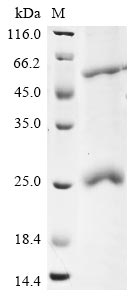This recombinant Human coronavirus HKU1 Protein I (N) comes from E. coli expression and spans the complete sequence from amino acids 1 to 205. The protein carries a C-terminal 6xHis-tag, which makes purification and detection more straightforward. SDS-PAGE analysis confirms the protein reaches over 85% purity. This product is meant strictly for research purposes and appears to offer a dependable resource for coronavirus protein studies.
The N protein from Human coronavirus HKU1 seems to play an essential role in how the virus replicates and transcribes its genetic material. It's involved in wrapping the viral RNA genome into the nucleocapsid and likely contributes to maintaining the virus's structural stability. Given its central position in coronavirus assembly, the N protein has become a major target for research into viral disease mechanisms and immune responses.
Potential Applications
Note: The applications listed below are based on what we know about this protein's biological functions, published research, and experience from experts in the field. However, we haven't fully tested all of these applications ourselves yet. We'd recommend running some preliminary tests first to make sure they work for your specific research goals.
The protein is expressed in E. coli (a prokaryotic system lacking eukaryotic post-translational modifications [PTMs]) as a full-length nucleocapsid protein (N) of Human coronavirus HKU1 (1-205 aa) with a C-terminal 6xHis tag. While full-length expression preserves the complete primary sequence, E. coli often fails to correctly fold viral nucleocapsid proteins, which typically require specific disulfide bond formation, RNA-binding pocket geometry, and proper oligomerization for native function. No experimental data confirms proper secondary/tertiary structure (e.g., circular dichroism spectroscopy, thermal shift assays) or bioactivity (e.g., RNA binding affinity, oligomerization capability). The protein may be partially or fully misfolded, limiting its ability to mimic native N protein function.
1. Antigen for Anti-HCoV-HKU1 Antibody Development
This recombinant N protein can serve as an immunogen for antibody generation, but antibody specificity must be validated against native N protein - E. coli-expressed protein may present non-native epitopes, leading to antibodies that fail to recognize the properly folded viral protein in infected cells. While the His tag facilitates purification and immobilization, the resulting antibodies should be tested for cross-reactivity with native N protein from eukaryotic expression systems or viral particles to ensure biological relevance.
2. Protein-Protein Interaction Studies Using Pull-Down Assays
Pull-down assays using the His tag can identify potential binding partners, but results are highly dependent on correct protein folding - misfolded N protein may yield false positives (non-specific interactions) or false negatives (missed genuine interactions). Any identified interactors require validation through co-immunoprecipitation with native N protein from infected cell lysates to confirm physiological relevance.
3. ELISA-Based Binding and Inhibition Assays
This protein can be used in ELISA formats, but quantitative results may not reflect native protein behavior if misfolding occurs. While suitable for initial screening, binding affinity measurements (KD values) and inhibitor screening results should be confirmed using a natively folded protein. The His tag enables consistent immobilization, but researchers should acknowledge that observed binding/inhibition patterns might not translate to the biological system.
4. Structural and Biophysical Characterization Studies
This recombinant protein is suitable for preliminary biophysical characterization (circular dichroism, dynamic light scattering, etc.), but results may not reflect native protein properties. These studies can assess basic folding stability but cannot validate native conformation without comparison to a properly folded reference standard. The C-terminal His tag may also influence oligomerization studies and should be considered when interpreting results.
Final Recommendation & Action Plan
This E. coli-expressed HCoV-HKU1 nucleocapsid protein has utility for initial research applications but requires rigorous validation before biological conclusions can be drawn. Prioritize structural characterization (circular dichroism, thermal shift assays) to assess folding quality, followed by functional validation (RNA binding assays, comparison with eukaryotic-expressed protein). For antibody development, validate resulting antibodies against native protein; for interaction studies, confirm findings with orthogonal methods. If the protein shows evidence of misfolding, consider alternative expression systems (baculovirus, mammalian cells) or include refolding optimization steps before proceeding with functional applications.






